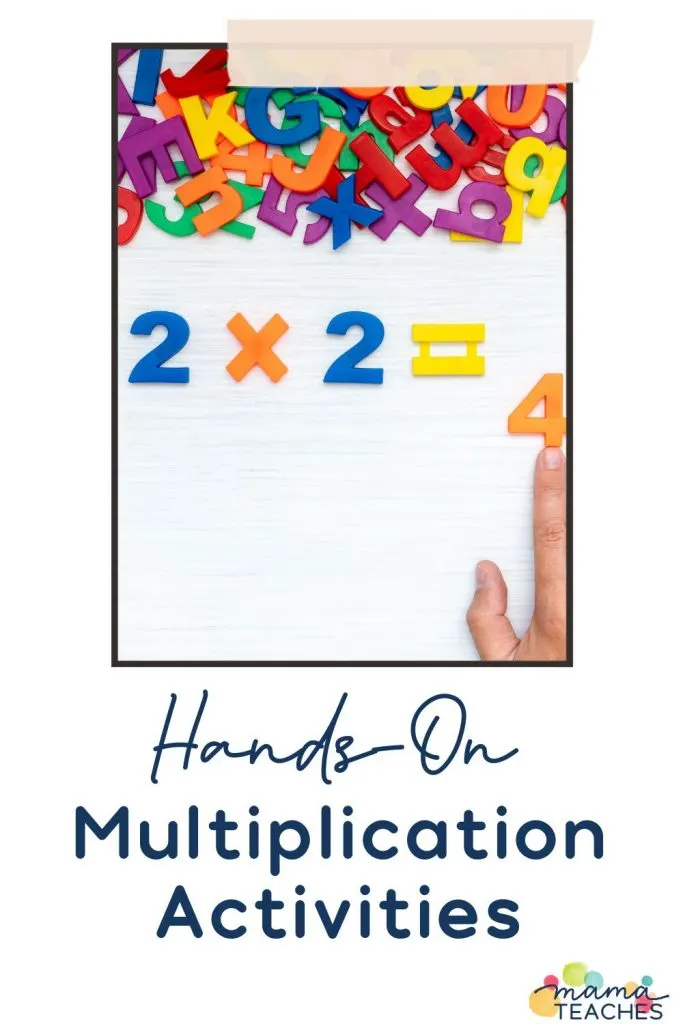Worksheets are only one way to teach multiplication.
Make math more enjoyable with these hands-on multiplication activities.

This article contains affiliate links to things that you might like.
Why Hands-On Multiplication Is Best
Math inspires a love or hate reaction.
If a child loves math, practicing multiplication will always be fun. If a child doesn’t like math, you have to be more creative to make math a friendly subject.
By incorporating hands-on multiplication activities, you not only appeal to the child’s sense of fun but also tap into kinesthetic learning.
Hands-on math activities also allow students to see the math in a new way, which can help them learn their math facts much more quickly.

Multiplication Activities That Are Hands-On
Each of these activities requires movement, a necessary part of kinesthetic learning.
Nines Trick with Hands
If you never learned this trick growing up, you will wish you had.
The multiples of 9 are 9, 18, 27, 36, 45, 54, 63, 72, 81, and 90.
You will notice that in each multiple, the digits add up to 9. For example, 45 has both a 4 and 5 (4 + 5 = 9).
Because of this trick, you can use your hands to determine the answer to a 9 multiplication fact.
Lay your hands palm down on a table.
Take the problem 9 x 1.
Put your first finger down (your left pinky).
How many fingers are to the right of that space created by the downed pinky?
Nine! 9 x 1 = 9
Now try it with 9 x 2.
This time, put down your second finger (your left ring finger).
How many fingers remain to left of the space?
One.
How many fingers remain to the right of the space?
Eight.
Put those two numbers (1 and 8 )together and you get 18. 9 x 2 = 18.
This nines trick works for all the multiplication facts from 9 x 1 to 9 x 10.

Building Arrays
Multiplication is, in essence, fast adding.
When you multiply 4 x 3, you are really adding up 4 groups of 3.
You can bring this concept to life by building arrays, which are rectangular representations of multiplication problems.
I love using square math tiles for this, but you can create arrays with anything rectangular like dominoes or playing cards.
Take a multiplication fact like 8 x 2, and create 8 rows of 2 each.
This creates a long, skinny rectangle.
Count the tiles and see that the answer is 16.
This is also a great way to learn about area.
Puzzles
Puzzles are games, so kids love them.
Leverage their fun factor by tieing them to multiplication practice.
You can make puzzles where the math fact is on one side, and the product is on the other.
For example, the child would match 6 x 3 with 18.
These Valentine’s Multiplication and Division Puzzles are simple to print and make.
You can make a set to reinforce multiplication and another to work on division facts.

Multiplication Games
Do you need some quick and easy math games?
Check out this list of 10 Multiplication Games for Kids Who Hate Math.
From Jenga to War to Kaboom, an energizing math game is sure to please even the most reluctant math student.
Multiplication Board Games
Board games are a fun way to reinforce multiplication concepts in the guise of a game.
You can play simple games with cards or dice or use a board game made especially for practicing multiplication.
Try Say Cheese, Tri-Facta, and Monster Sock Factory.
Multiplication Activities That Enhance Learning
Multiplication activities are a fun and fast way to reinforce those all-important multiplication math facts.
These activities are more than just a diversion from traditional math practice.
By working on multiplication in a hands-on way, you can help the concept of multiplication stick.
